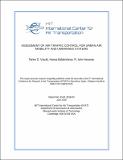| dc.description.abstract | This paper assesses how the introduction of urban air mobility services and unmanned aircraft systems may challenge Air Traffic Control (ATC) in the United States and what opportunities exist to support these forthcoming operations. Four attributes unique to these emerging operations were identified that may challenge effective ATC. Each attribute concerned the scalability of current ATC systems to support a large number of new airspace users at low altitudes. Six potential operational limitations were identified that ATC may impose upon airspace users in an effort to manage increased traffic demand. The fundamental mechanisms that set the aircraft capacity of an airspace, considered to be a surrogate for ATC scalability, were determined. The influence of ATC system architecture, technologies, and operational factors on these mechanisms was diagramed. Finally, the ability of various new ATC approaches to support high density, low altitude operations were reviewed with respect to these mechanisms. | en_US |
